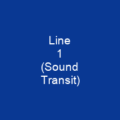University of Washington Station: A Gateway to Progress
Imagine stepping into a portal that connects you not just to a city but to an entire university campus. That’s what the University of Washington station does, serving as more than just a transit hub—it’s a gateway to progress and innovation. Located on the bustling University of Washington campus in Seattle, this light rail station is part of Sound Transit’s Link light rail system, specifically the 1 Line. Built as part of the University Link Extension, it opened its doors on March 19, 2016, marking a significant milestone for both transportation and urban development.
The Journey Begins
As you approach the station, you’ll find yourself at the intersection of Montlake Boulevard Northeast and Northeast Pacific Street. This location is strategically placed near Husky Stadium and the University of Washington Medical Center, making it a vital link in the city’s transportation network. The surrounding area supports 15,511 jobs and 488 residents, positioning it as one of Seattle’s major employment centers.
A Historical Perspective
The idea for this station dates back to the 1910s when a comprehensive subway system was first proposed. However, like many grand plans, it faced numerous rejections and revisions over several decades. It wasn’t until the formation of Sound Transit in the 1990s that the project gained momentum. The University Link Extension, with Husky Stadium as its northern terminus, received final approval in 2006, setting the stage for what was to become a transformative station.
Construction and Challenges
The construction of the station began in 2009 with an $813 million federal grant. Utility relocation and site preparation were completed by 2010, followed by excavation and installation of structural elements. The station’s basic structure was finished in early 2014, just as landscaping and road access around the entrance were being restored.
One notable challenge during construction was the temporary ‘Great Wall of Us’ installed on the fence surrounding the site. This creative solution not only provided a barrier but also engaged the community with art and design.
A Modern Hub
The station is designed to accommodate large crowds, featuring 13 escalators and a mezzanine with a capacity of 1,600 people. It’s more than just a transit hub; it’s a space that fosters community interaction and connectivity. The station’s design includes a two-story glass building and a bridge over Montlake Boulevard, complete with bicycle racks and pay parking nearby.
Public art also plays a significant role in the station’s ambiance. Subterraneum by Leo Saul Berk, consisting of 6,000 backlit LED panels lining the walls of the chamber, adds an artistic touch to the underground space.
Integration with Other Services
The University of Washington station serves as a major bus hub, with seven stops serving routes from Northeast Seattle and the Eastside. Additionally, three Sound Transit Express routes connect to this station, making it a central point for commuters and students alike.
While the 1 Line connects to U District, Capitol Hill, and Downtown Seattle via the University Link tunnel, the station’s role extends beyond just transportation. It serves as a gateway to the university campus, connecting students, faculty, and visitors with ease.
A Future of Possibilities
The station has faced its share of challenges, such as broken escalators in 2018 and a bent pantograph damaging overhead wires in September 2024. However, these incidents have also led to improvements, like the cancellation of plans to replace the 13 escalators due to improved performance from preventative maintenance.
Looking ahead, the station continues to evolve with the university’s long-term plans for redevelopment along Montlake Boulevard into additional office and classroom space, forming a new ‘East Campus’ area. This vision aligns perfectly with the station’s role as a central hub of connectivity and progress.
The University of Washington Station: A Beacon of Progress
As we stand at the University of Washington station, it’s hard not to feel a sense of excitement and anticipation for what lies ahead. This station is more than just a transit point; it’s a symbol of Seattle’s commitment to innovation, progress, and community. From its historical roots to its modern design, the station stands as a testament to how transportation can shape our cities and enhance our lives.

You want to know more about University of Washington station?
This page is based on the article University of Washington station published in Wikipedia (retrieved on December 1, 2024) and was automatically summarized using artificial intelligence.







